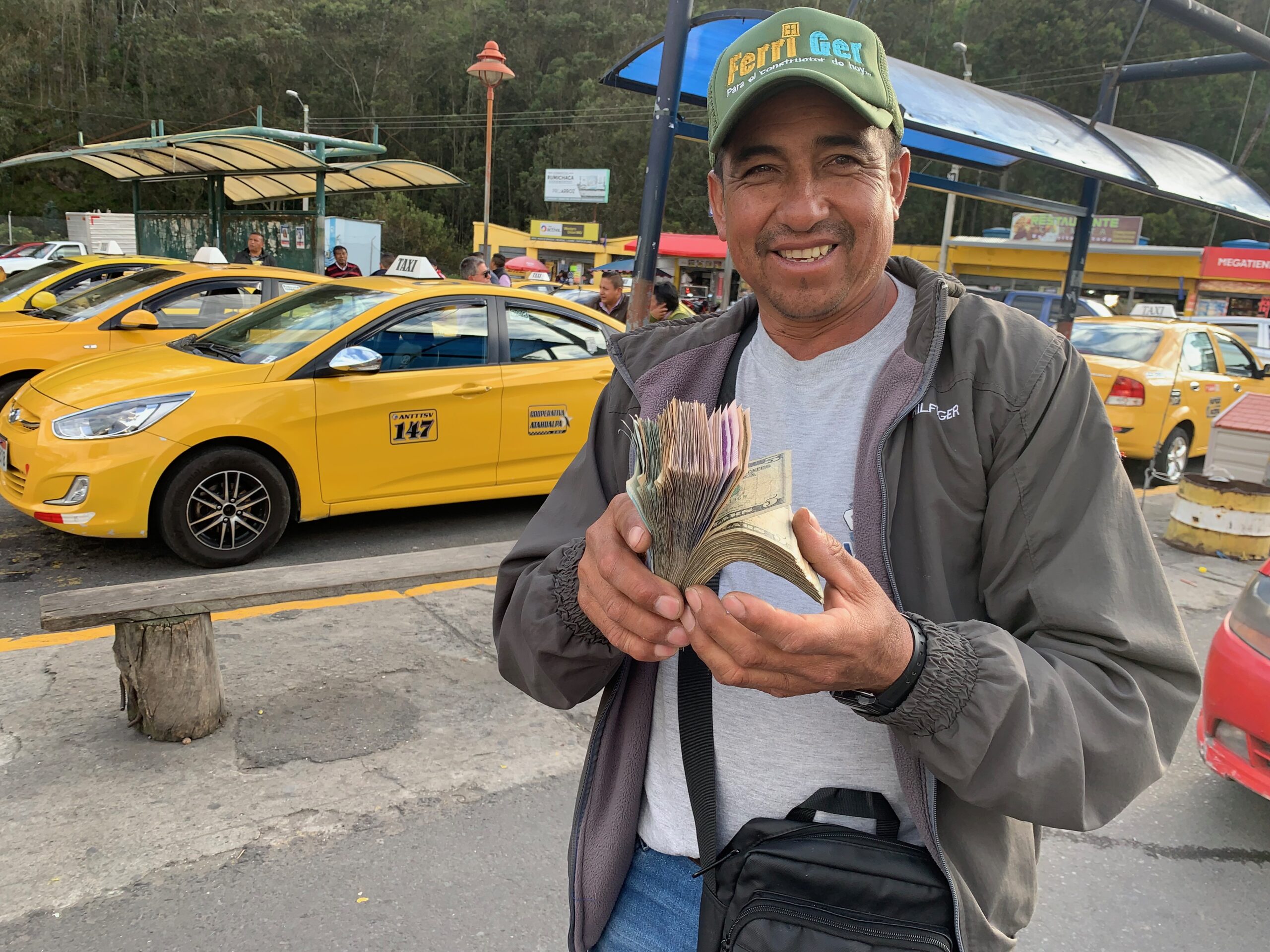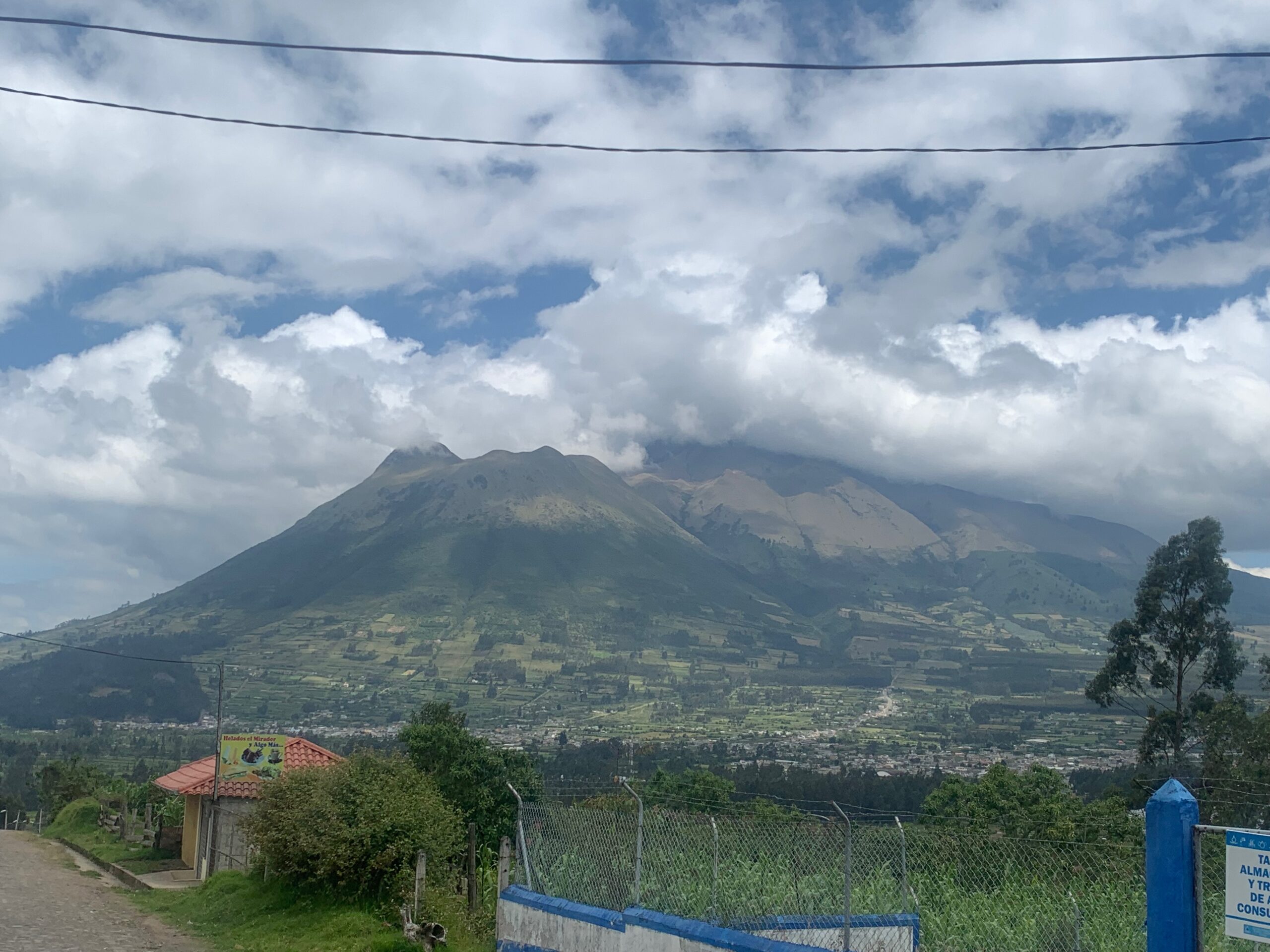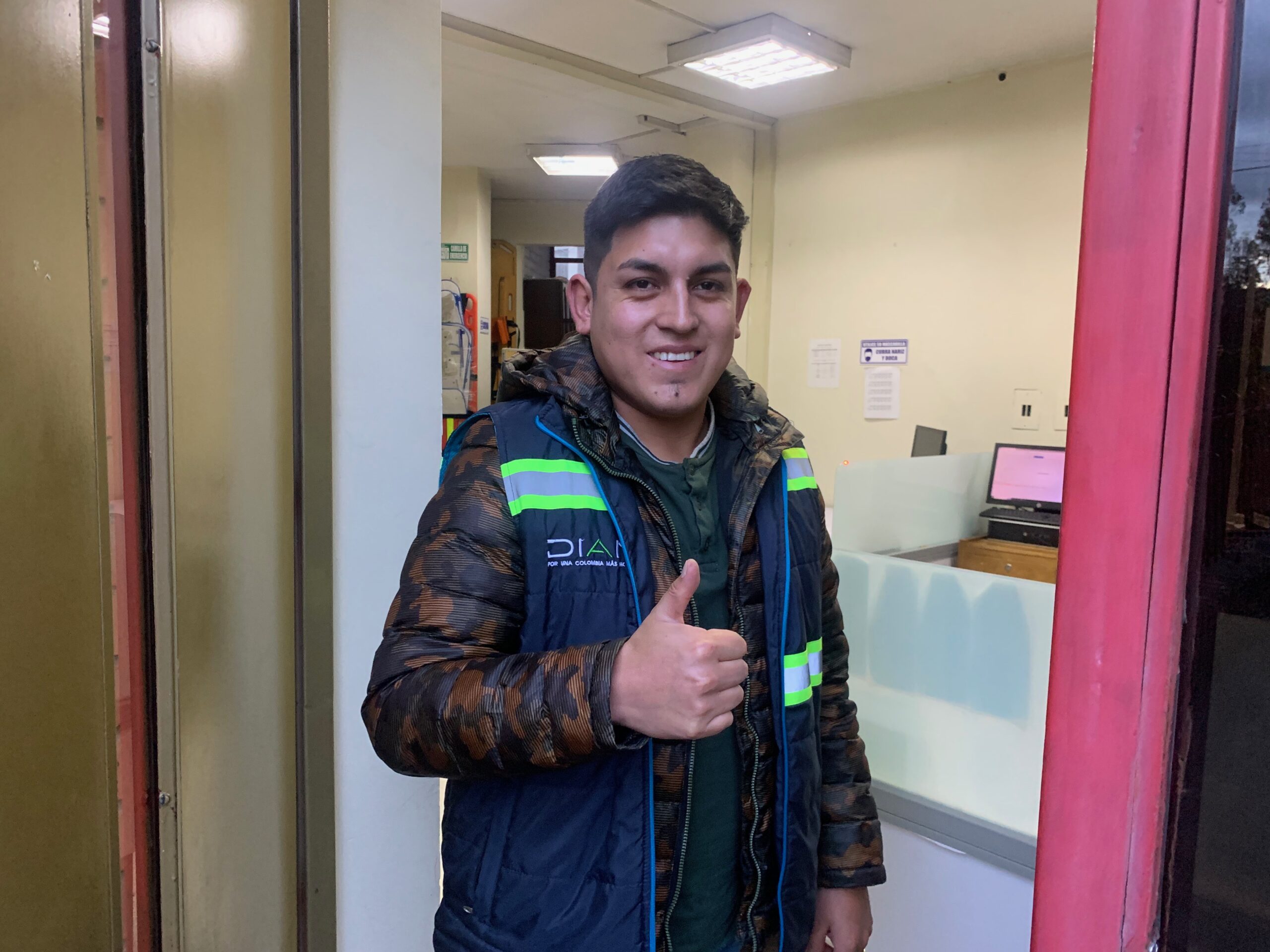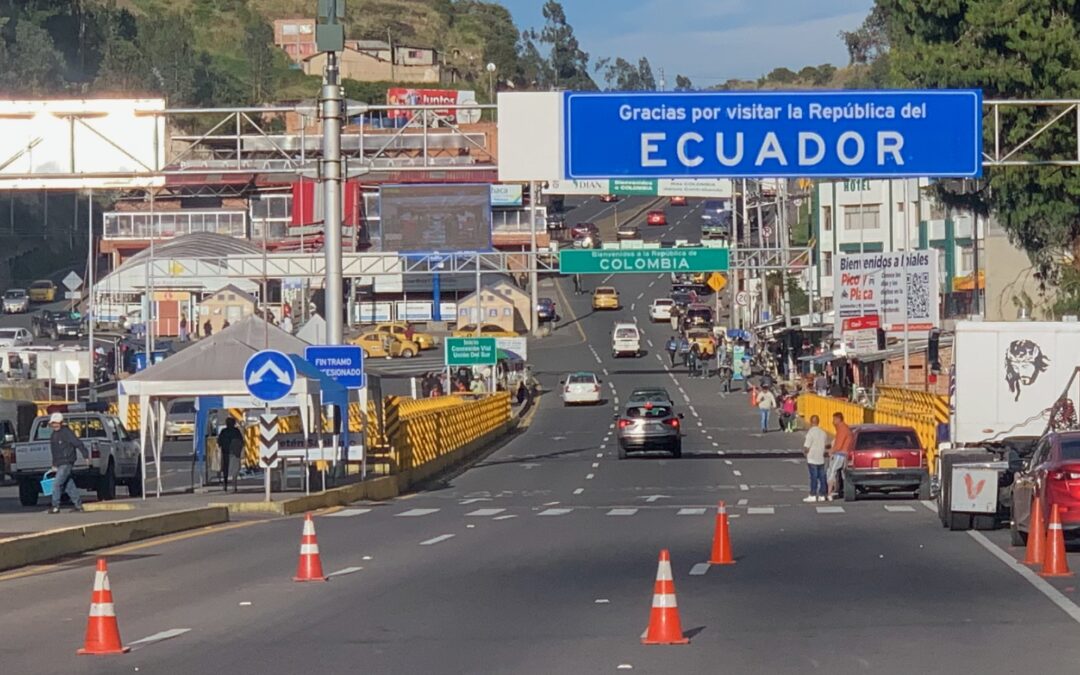February 8th 2013, Ipiales, Colombia.
“What do you think,” I said to the Ecuadoran customs officer in military-style uniform sitting under the little canopy by the roadside, “he gave me 86,000 Colombian pesos for $20. Is that good?”
The customs guy took out his calculator and after some tap, tap, taping, told me: “Si, es bueno.” And so I went back to the dealer on the other side of the road and got some more, managing to up the rate to 90,000 per $20.

Border crossings can be strange places at the best of times. Buying what one assumes is black-market currency from blokes waving fistfuls of cash at you always has a furtive aspect to it. Being aided in how to get the best rate by a customs agent is, well, definitely on the weird side.
The Ecuador/Colombia frontier crossing just beyond Tulcán, appears quite suddenly. I left Quito and crossed the equator at Mitad del Mundo, straddling its yellow line so one foot was in the northern hemisphere, while the other was in the southern, like everyone does that passes this way. I also left behind the dream of at least seeing Chimborazo and Cotopaxi, those two volcanoes of childhood poetic memory. WJ Turner’s poem Romancehas occupied several of my brain cells for well over 50 years —
When I was but thirteen or so
I went into a golden land,
Chimborazo, Cotopaxi
Took me by the hand . . .
I had given up the notion of climbing Chimborazo. At 6,314 meters above sea level and festooned with glaciers, it is the highest mountain in South America and standing on the summit, one is closer to the sun than at any other point on planet earth, even the top of Mount Everest. How come? Hint: the earth is not a perfect sphere. Both mountains which are close to Quito were smothered in low cloud and drizzle as I passed but there is something wonderful about the notion that mountains would capture a child’s imagination and take them by the hand.

By the time I got to Otavalo, north of Quito, the volcanic mountain Imbabura (4,609) was almost wholly visible, the cone of a lesser volcano on its side had collapsed and the castellated ridge of what remained stood out, black against the sky.
And then the frontier. Rounding a bend as the road swung down into a valley, suddenly it’s there. On the right, a car park filled with yellow taxis and those freelance currency traders, black market or otherwise, I know not. On the left, a cluster of buildings housing the Ecuadoran immigration police and the aduana, the customs. Ahead, a short bridge crossing the valley and a huge blue sign over the road — thank you for visiting the republic of Ecuador, it says in Spanish — and, as the road rises out of the valley, another huge green sign over the road, welcome to the republic of Colombia. My friendly customs exchange rate advisor shows me where to go and I sail through the Ecuadoran side without a hitch, while also picking up some useful advice from two Brazilian fellows heading in the opposite direction to me. They have up to date intel about the mud slides and road blockages in southern Colombia and suggest alternative routes on the way to Bogota.
On the Colombian side, I am immediately lit upon by several men of indeterminate status who seem to want to take me over. Park here, go there, no, not there, here, go that way, then there, that window . . . etc etc. I have no idea who they are, they look far from having any official status and I see no reason to trust them. But eventually, I get my passport stamped for entry and then go to the Colombian customs window — blacked out and with a tiny sliding window, covered by a metal grill, at the bottom of it. The grill swishes open and I hand in my passport, driving licence and the motorbike’s Irish registration document — as I have done at every other border crossing. Only this time, there comes back the request for the other form I’m supposed to have filled in — which turns out to be the main form.
I am told this can only be done online and am pointed to a poster telling me what to do — online. Do you have WiFi, I ask? No, they don’t have WiFi. How can I fill in the form then, I ask. You must do it online. Swish!
And so it goes on like this for maybe 10 minutes. I am close to tears in frustration. I cannot do what they demand but do not provide the means — WiFi — for me to execute. And, to cap it all, I am now in no man’s land: I have left Ecuador and have technically entered Colombia, as my passport proves, but my bike has not, or at least not legally. And it’s approaching 6pm and getting dark rapidly as it does around the equator.
Eventually, a young customs official, Javier, comes to my rescue. He leads me from the swishing window around the back and inside the building to a small room with a desktop computer. We have somehow to logon and fill in the form and then access my email because that is how the customs system will communicate with me — approving the bike’s temporary entry to Colombia and, crucially, giving me the necessary excise waiver documentation so it can leave again. But nothing’s working: we can’t logon, either as him or me until Javier uses a different logon identity, I have no idea whose, and between us, we fill in the form — chassis number, engine number, reg, year of manufacture etc, etc. And after several attempts, Javier links his phone to mine and we access my email and, Hoop-La!, it is done.

Soon, my phone is pinging with incoming emails giving me the necessary documents and, as I leave, Javier hands me a hard copy of the most important paper, the one with the number, the one relating to the bike’s approval to enter Colombia and, I assume, in a week or two, to leave.
I ride on, the darkness enveloping everything and I notice a worrying lack of hostels or hotels so I just have to continue moving along the road until I stumble upon one. That happens on the far side of a place named Ipiales where a hotel has safe parking, WiFi, and a double bedroom with en suite . . . for 40,000 pesos. That’s about €10 at the border crossing, street trading, loadso’money fist full of cash, customs official approved, freelance rate.
It’ll do just grand.
This was published first in the Irish Times online on February 13th 2023

Ah yes, those border crossing nightmares…but people are always willing to help, and there’s always a solution!
I’m reading about your border experience and my anxiety levels are at 9. You are an adrenaline junkey at this stage I imagine.
All’s well that ends well! Got there… and further too! And yes, it is exciting… if exhausting at the same time.
Great articles Peter. I also have a GSA and will be doing the Nordkapp this summer – small beer compared to what you are doing. I’m curious about what kind of insurance you have for this trip. It must be through a specialist broker as the regular Irish guys aren’t usually interested in anything out of the ordinary.
Kind Regards,
Con
Ha! I’d love to do the Nordkapp and feel certain I will. Next year maybe! On insurance, I got some in Argentina that covered there and all countries with a shared border with Argentina. For Ecuador and Colombia, I have had none and I was told only yesterday that were I involved in any sort of accident in Colombia without insurance, I would be pout in jail immediately until the mess was sorted out! I have today started trying to sort out insurance for Panama! The Argentine insurance cost mere pennies so where I can get it, its not costly… Best of luck with your adventure. Finnmark, the Norwegian province of the North Cape is interesting. I’ve been there twice in winter… which is something else!
Thanks for the update! Argentinian insurance sounds like a great deal.
Re. Venezuela, I lived there for 2.5 years in the 80´s and that is where my wife is from. It’s a shame how Chavez and Maduro managed to wreck a country in such a short space of time. Socialism is great until you run out of other peoples money to spend.
Maith an fear P
Didn’t realise Venezuela was so deep in the sh.. hard to believe as I was fond of Chavez as a che guavara type – guess Charlie wasn’t too bad but methinks he was cut from the same flag as Maduoro !! Great trip makes me envious of your bravery and adventurous Spirit
Togh go bogh é ie Tranquilo !!
Thanks… yes, it is a great trip. Feel sorry for Venezuela; the country should be so prosperous.
Hi Peter just catching up on your blogs and again you are reminding me of great memories. You should have stayed a few days in Otavalo. Wonderful midweek market there. As you said no shortage of help offered from strangers at the border crossing. I availed of one and was in Ipiales in no time! No problems!
Yep, so many places, so much to see, so little time!